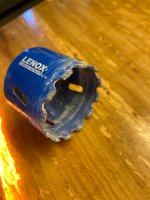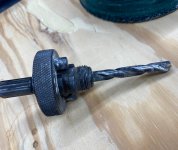dlu
Member
I need to drill one 115mm/4.5" hole – ish, it just needs to provide reasonable clearance for 4" triple wall drain pipe) – (or maybe two if I blow it the first time  ) in a 1 3/4" thick concrete paver. I'm thinking that I would use my Milwaukee M18 SDS-plus hammer drill, but I'm striking out all over the place looking for a bit. I was hoping to find a semi-serviceable "one-hole wonder" on Amazon (I don't see too many more downspouts going through pavers in my future), I'd be willing to buy a Bosch Speedcore (or the like), but my Google foo just isn't working and I'm either coming up empty handed or finding $500+ bits that look like they can cut an 8" core…
) in a 1 3/4" thick concrete paver. I'm thinking that I would use my Milwaukee M18 SDS-plus hammer drill, but I'm striking out all over the place looking for a bit. I was hoping to find a semi-serviceable "one-hole wonder" on Amazon (I don't see too many more downspouts going through pavers in my future), I'd be willing to buy a Bosch Speedcore (or the like), but my Google foo just isn't working and I'm either coming up empty handed or finding $500+ bits that look like they can cut an 8" core…
So, I'm looking for suggestions. A source for a 4.5" SDS core bit, other ideas for bits (I stumbled on claims that the Sypder carbide bits will cut brick, but haven't found an SDS mandrel – would a conventional mandrel work in an SDS chuck adapter?), or tricks for cutting a relatively clean round hole in concrete pavers.
So, I'm looking for suggestions. A source for a 4.5" SDS core bit, other ideas for bits (I stumbled on claims that the Sypder carbide bits will cut brick, but haven't found an SDS mandrel – would a conventional mandrel work in an SDS chuck adapter?), or tricks for cutting a relatively clean round hole in concrete pavers.




